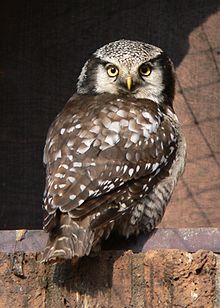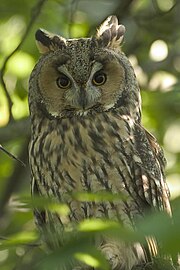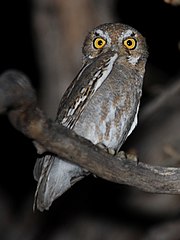Real owls
| Real owls | ||||||||
|---|---|---|---|---|---|---|---|---|

|
||||||||
| Systematics | ||||||||
|
||||||||
| Scientific name | ||||||||
| Strigidae | ||||||||
| Vigors , 1825 |
The family of the real owls (Strigidae) is the larger of the two families of the owls (Strigiformes). The second, smaller family is that of the barn owls (Tytonidae). With the exception of Antarctica , representatives of this family have colonized all continents; very many species are island endings .
In contrast to the barn owls, which are quite uniform in size and appearance, the representatives of the real owls are very variable. Some of the heaviest and largest species reach a length of over 70 centimeters and a weight of over 4 kilograms. The smallest, on the other hand, are only slightly larger than a sparrow (from 14 centimeters) and weigh only around 50 grams (females around twice that). Females are generally a little heavier, sometimes significantly heavier than males.
König and Weick differentiate between 24 genera with 214 species, 56 of which are listed in different hazard levels of the IUCN . Among them, 11 species are endangered and 4 critically endangered . At least 8 species became extinct in prehistoric and historical times. All were islanders.
Appearance
The plumage is very rich. The individual feathers are large, rounded at the end, very finely grained, soft and flexible. Most members of the family show a little contrasting, rather gloomy plumage, which has light and dark spots, bands or sparrowths with a brown, gray-brown and sometimes reddish-brown base tone . A noticeable color dimorphism does not exist in any species. The wings are usually long, wide and trough-shaped and the outer flags of the hand wings are fringed.
The owls are birds with a stocky body and a relatively large head, often with tufts of ears. The beak is short, strong, curved down from the root and toothless. The short wax skin and the beak are often almost completely covered by feathers. The ear opening is large, usually protected by a membranous ear cover and surrounded by a wreath of stiff feathers (veil), which often spreads over the whole face and throat. Spring ears are formed in about half of the species .
The eyes are strikingly large and directed forward. Since the eyes are rigid, the neck is all the more flexible: it can be rotated up to 270 ° in both directions.
The tail is short and small. The legs are usually feathered down to the claws. The toes are relatively short, the outer toe is a turning toe. The claws are large, long, strongly curved and very pointed.
Habitat and way of life

The owls can be found widespread in all zones, live mostly in forests, but also in steppes, deserts and near human dwellings; very many are nocturnal birds of prey and their soft plumage, their silent flight, their very keen eyes and fine hearing for short distances make them particularly capable. The eye is sensitive to daylight, and some species close it halfway or more during the day. Only a few species hunt in broad daylight, but none exclusively during the day.
They are very agile, but mostly clumsy on earth; the flight is comparatively slow, and only on long migrations do they rise to a considerable height.
nutrition
The food spectrum is very diverse according to the very different body sizes and habitats and ranges from flying insects to small mammals (mainly mice and shrews ), small birds, amphibians and bats to mammals the size of rabbits and correspondingly heavy birds (especially chicken birds ). They devour the prey in large bites and spew bones, hair and feathers, balled into balls ( bulges ), usually in a certain place. Carrion is spurned. Some species also specialize in fishing.
voice
The voice is usually loud; some screeching, others give very peculiar sounds to be heard and have nurtured a lot of superstition through this and their nocturnal nature.
Reproduction
Many species are cave-breeders or breed in rock niches, in crevices, in the structures of mammals, on tree stumps or in old birds of prey or crows nests. Owls do not build their own nests; rudimentary nest building activities can only be observed in very few species. They lay 2 to 10 white eggs that may be incubated by both sexes. The young sit in the nest for a long time and are faithfully cared for and courageously defended.
Genera and selected species
This representation follows König and Weick with the subfamily classification by Winkler and colleagues and additions from the IOC World Bird List.

- Subfamily Ieraglaucinae
-
Bush owls ( Ninox ) - 25 species - e.g. B .:
- Kläfferkauz ( Ninox connivens )
- Giant owl ( N. strictua )
- Boobook owl ( N. boobook )
- Hawk Owl ( N. scutulata )
- † Laughing owls ( Sceloglaux )
- † barnacle owl ( S. albifacies )
-
Round- winged owl ( Uroglaux ) - monotypical
- Round- winged owl (
-
Bush owls ( Ninox ) - 25 species - e.g. B .:
- Subfamily Sukiinae
-
Little owls ( Athene ) - 6 species e.g. B .:
- Little Owl ( Athene noctua )
- Rabbit Owl ( A. cunicularia )
- Blewitt-Kauz ( A. blewitti ) - thought to be extinct (rediscovered in 1997)
-
Aegolius - 4 species, e.g. B .:
- Little Owl ( A. funereus )
- Saw owl ( A. acadicus )
-
Pygmy owls ( Glaucidium ) - approx. 25 species, e.g. B .:
- Pygmy Owl ( Glaucidium passerinum )
- Pearl owl ( G. perlatum )
- Wachtelkauz ( G. brodiei )
- Rocky Mountains pygmy owl ( G. californicum )
- Amazon pygmy owl ( G. hardyi )
-
Elf owls ( Micrathene ) - monotypical
- Elf Owl ( Micrathene whitneyi )
-
Hawk owls ( surnia ) - monotypical
- Hawk owl ( surnia ulula )
-
Peruvian owls ( Xenoglaux ) - monotypical
- Peruvian Owl ( Xenoglaux loweryi )
-
Little owls ( Athene ) - 6 species e.g. B .:
- Subfamily Striginae
-
Ear Owls ( Asio ) - 7 species, e.g. B .:
- Long-eared Owl ( Asio otus )
- Short-eared Owl ( A. flammeus )
- Hoot ( A. clamator )
-
Eagle owls ( Bubo ) - 19 species - 2 subgenera: Nyctea (monotypical) and Bubo (18 species) z. B.
- Eagle owl ( Bubo bubo )
- Snowy Owl ( B. scandiacus )
- Great horned owl ( B. virginianus )
- Magellanic eagle owl ( B. magellanicus )
- Desert Owl ( B. ascalaphus )
- Kapuhu ( Bubo capensis )
- † Grallistrix
-
Mane owls ( Jubula ) - monotypical
- Maned Owl ( Jubula lettii )
- Fischuhus ( Ketupa ) (3 species)
-
Hooded owls ( Lophostrix ) - monotypical
- Crested Owl , Haubeneule ( Lophostrix cristata )
-
Margarobyas - monotypical - formerly at Megascops or Gymnoglaux
- Cuban Owl ( Margarobyas lawrencii )
-
Screech owls ( Megascops ) - 27 species, e.g. B .:
- White-throated Screech Owl ( Megascops albogularis )
- Eastern Screech Owl ( M. asio )
- Guatemala Screech Owl ( M. guatemalae )
- Choliba Screech Owl ( M. choliba )
-
Mimizuku - monotypical; earlier with Otus , occasionally also with Bubo
- Red-eared Owl ( Mimizuku gurneyi )
-
Solomon Owls ( Nesasio ) - monotypical
- Solomon Owl (
-
Ear Owls ( Asio ) - 7 species, e.g. B .:
-
Scops owls ( Otus ) incl. Mascarenotus - 51 recent species, e.g. B .:
- Scops Owl ( Otus scops )
- Rajah scops owl ( O. brookii )
- Torotoroka scops owl ( O. madagascariensis )
- African scops owl ( O. senegalensis )
- † Mauritius owl ( O. sauzieri )
- † Reunion owl ( O. grucheti )
- † Rodrigues owl ( O. murivorus )
-
Jamaican owls ( pseudoscops ) - monotypical
- Jamaican owl ( Pseudoscops grammicus )
-
Psiloscops - monotypical, formerly in Otus
- Ponderosa Owl ( P. flammeolus )
-
White-faced owls ( Ptilopsis ) - 2 species; formerly at Otus
- Northern bush owl ( Ptilopsis leucotis )
- Südbüscheleule ( P. granti ) - even as a subspecies of P. leucotis considered
-
Eyeglasses ( pulsatrix ) - 4 types
- Owl ( P. perspicillata )
- Short-browed owl ( Pulsatrix pulsatrix )
- Yellow- eyed owl ( P. koeniswaldiana )
- Coated Owl ( P. melanota )
-
Pyrroglaux - monotypical, earlier in Otus or Megascops
- Palau owl ( Pyrroglaux podarginus )
- Fish owls ( Scotopelia ) (3 species)
-
Strix - 25 species, e.g. B .:
- Tawny Owl ( Strix aluco )
- Great gray owl ( S. nebulosa )
- Ural owl ( S. uralensis )
- Pagoda Owl ( S. seloputo )
- Spotted owl ( S. occidentalis )
- Rust-footed owl ( S. rufipes )
- Taenioglaux - 9 species; formerly Glaucidium . z. B .:
literature
- John A. Burton (ed.): Owls of the world - development - physique - way of life . Neumann-Neudamm Verlag, Melsungen 1986, ISBN 3-7888-0495-5 .
- Wolfgang Epple: Owls - The mysterious birds of the night . Gräfe and Unzer Verlag, Munich 1994, ISBN 3-7742-1790-4 .
- Claus König and Friedhelm Weick : Owls of the World . Christopher Helm, London 2008, ISBN 978-0-7136-6548-2 .
- Theodor Mebs / Wolfgang Scherzinger : The owls of Europe - biology, characteristics, stocks . Kosmos Verlag, Stuttgart 2000, ISBN 3-440-07069-7 .
- Jürgen Nicolai : Birds of prey and owls . Gräfe and Unzer Verlag, Munich 1987, ISBN 3-7742-3805-7 , ( compass nature guide ).
Individual evidence
- ↑ a b König & Weick (2008) pp. 233–489
- ↑ Köenig & Weick (2008) pp. 40–42
- ↑ (.odt) ( Memento of the original from October 22, 2013 in the Internet Archive ) Info: The archive link was inserted automatically and has not yet been checked. Please check the original and archive link according to the instructions and then remove this notice. ( MS Word ; 228 kB)
- ↑ Owls and Owls , waltus.ch; Retrieved December 9, 2015
- ↑ David W. Winkler, Shawn M. Billerman, Irby J. Lovette: Bird Families of the World, A Guide to the Spectacular Diversity of Birds. Lynx Edicions Publications, 2016, ISBN 978-84-941892-0-3 . Page 204–205
- ↑ Owls in the IOC World Bird List






